Fault Code 320: Rail E Position
J1939: SA 3 SPN 5942 FMI 0, 1, 2, 3, 4, 5, 6, 8, 9, 10, 12, 16, 18, 20, 21
Overview
The Endurant XD Series transmissions are equipped with 5 shift rail position sensors and 5 magnets mounted on shift rails A, B, C, D and E. The shift rail position sensors monitor the position of the shift rail magnet and provide the information to the Transmission Control Module for the purpose of making shift decisions, confirming gear engagement, and monitoring shift rail positions. Shift Rail E actuates the Rail E Synchronizer to engage High and Low Range. The position sensors are located in the Mechatronic Transmission Module (MTM) and are connected to the Transmission Control Module (TCM) at the 74-Way Transmission Harness Connector.
Detection
The TCM monitors Shift Rail E position. If a system failure is detected, the fault is set Active.
Conditions to Set Fault Code Active
FMI 0 – Data Valid But Above Normal (Most Severe): Shift Rail E movement beyond the calibrated High Range engagement position for 1 second.
FMI 1 – Data Valid But Below Normal (Most Severe): Shift Rail E movement beyond the calibrated Low Range engagement position for 1 second.
FMI 2 – Data Erratic: Rail E Position duty cycle out of range for 1 second.
FMI 3 – Voltage Above Normal or Shorted High: Rail E Position Sensor circuit shorted to power for 1 second.
FMI 4 – Voltage Below Normal or Shorted Low: Rail E Position Sensor circuit shorted to ground for 1 second.
FMI 5 – Current Below Normal or Open Circuit: Rail E Position Sensor circuit open for 1 second.
FMI 6 – Current Above Normal or Grounded Circuit: Rail E Position Sensor circuit supply voltage out of normal operating range (4.75V to 5.25V) for 1 second.
FMI 8 – Abnormal Frequency: Rail E Position Sensor signal frequency out of range for 1 second.
FMI 9 – Abnormal Update Rate: Rail E Position Sensor did not detect Shift Rail E magnet for 1 second.
FMI 10 – Abnormal Rate Of Change: Rail E Position value rate of change exceeded when no Shift Rail E movement commanded for 1 second.
FMI 12 – Bad Intelligent Device: Rail E Position Sensor circuit self-check failure for 1 second.
FMI 16 - Data Valid but Above Normal (Moderately Severe): Uncommanded Shift Rail E movement from High Range toward neutral position while speed sensors continued to indicate a High Range gear ratio.
FMI 18 – Data Valid but Below Normal (Moderately Severe): Uncommanded Shift Rail E movement from Low Range toward neutral position while speed sensors continued to indicate a Low Range gear ratio.
FMI 20 – Data Drifted High: Rail E Position value indicated High Range disengagement but speed sensors and torque continued to indicate a High Range gear ratio for 2 seconds.
FMI 21 – Data Drifted Low: Rail E Position Sensor indicated Low Range disengagement but speed sensors and torque continued to indicate a Low Range gear ratio for 2 seconds.
Fallback
FMI 0, 1, 2, 3, 4, 5, 6, 8, 9, 10, 12, 16, 18, 20, 21
- If Rail E position is known and Rail E is either fully engaged or disengaged:
- Amber warning lamp on
- Shift Rail E movement prohibited
- If Rail E position is not known and Rail E is either not fully engaged or disengaged:
- Amber warning lamp on
- Shift Rail E movement prohibited
- Urge to Move and Creep Mode prohibited
- Non-Neutral Modes prohibited
- PTO mode prohibited
- If vehicle is moving – Red stop lamp on
Conditions to Set Fault Code Inactive
FMI 0, 1, 10, 16, 18, 20, 21: Key cycle and fault condition no longer exists.
FMI 2: Rail E Position duty cycle in range for 10 seconds.
FMI 3: Rail E Position Sensor circuit not shorted to power for 10 seconds.
FMI 4: Rail E Position Sensor circuit not shorted to ground for 10 seconds.
FMI 5: Rail E Position Sensor circuit not open for 10 seconds.
FMI 6: Rail E Position Sensor signal voltage between 4.75 and 5.25 volts for 10 seconds.
FMI 8: Rail E Position Sensor signal frequency in range for 10 seconds.
FMI 9: Shift Rail E magnet detected for 10 seconds.
FMI 12: Rail E Position Sensor circuit self-checks in range for 10 seconds.
Possible Causes
FMI 0, 1:
- MTM
- Rail E Yoke
- Internal Transmission
- Rail E Synchronizer
FMI 2, 3, 4, 5, 6, 8:
- MTM - Rail E Position Sensor
- Damaged
- Internal failure
- MTM - Transmission Harness
- Wiring shorted to power, shorted to ground or open.
- TCM
- Software issue
- Internal failure
FMI 9:
- MTM Installation
- Rail E notch facing down
- MTM - Rail E Cylinder
- Magnet loose
- Magnet detached
- MTM - Rail E Position Sensor
- Loose
- Damaged
FMI 12:
- TCM
- Software issue
- Internal failure
FMI 10, 20, 21:
- MTM - Rail E Position Sensor
- Internal failure
FMI 16, 18:
- MTM - Rail E Position Sensor
- Internal failure
- Internal transmission
- Rail E Detent
- Rail E Shift Rail
- Rail E Synchronizer
Additional Tools
- Endurant XD Service Manual TRSM0960
- Eaton Breakout Box with 74-Way Eaton Diagnostic Adapter - RR1029TR
- Digital Volt/Ohm Meter (DVOM)
Component Identification
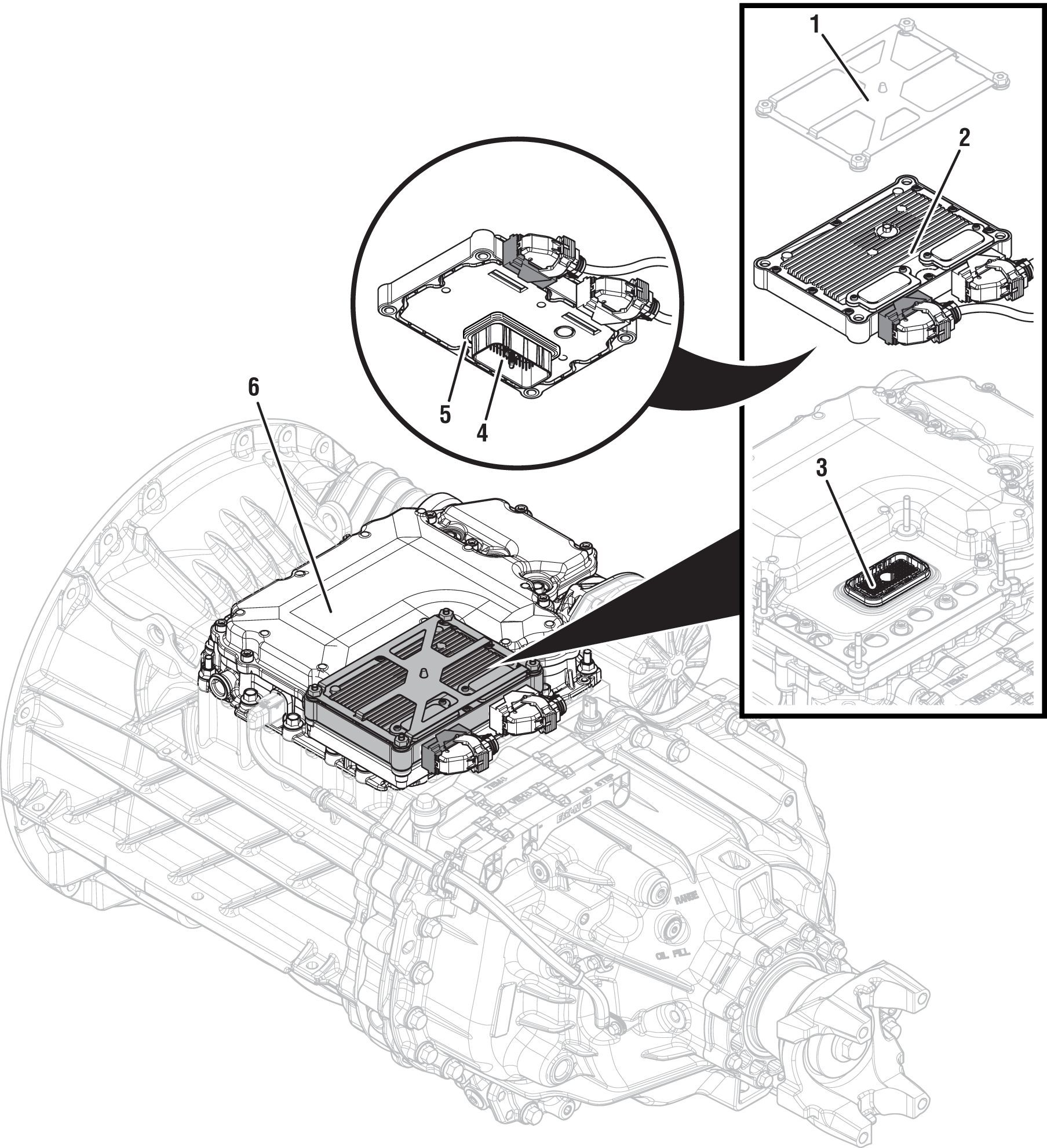 |
1. Transmission Control Module (TCM) Cover 2. Transmission Control Module (TCM) 3. 74-Way Transmission Harness Connector (TCM-side) 4. 74-Way Transmission Harness Connector (MTM-side) 5. Transmission Control Module (TCM) Seal 6. Mechatronic Transmission Module (MTM) |
Fault Code 320 Troubleshooting
Set vehicle parking brake and chock wheels.
Record transmission fault codes, FMIs, occurrences, and timestamps from Service Activity Report created during the Diagnostic Procedure.
If Fault Code 320 FMI 0, 1 is Active or Inactive, Go to Step D
If Fault Code 320 FMI 2, 3, 4, 5, 6, 8, 10, 16, 18, 20, 21 is Active or Inactive, Go to Step B
If Fault Code 320 FMI 9 is Active and MTM was recently replaced, Go to Step E
If Fault Code 320 FMI 9 is Active or Inactive and MTM was not recently replaced, Go to Step B
If Fault Code 320 FMI 12 is Active or Inactive, Contact Eaton Cummins Automated Transmission Technologies for further diagnostic instructions. For Help Line phone numbers, go to Contact Information. Go to Step V
Key off.
Remove TCM from MTM with 20-Way TCM Vehicle Harness Connector and 20-Way TCM Body Harness Connector connected.

Inspect TCM side of the 74-Way Transmission Harness Connector, verify connector is free from contamination and corrosion; terminals are not bent, spread or loose; and there is no damage to connector body.
Inspect TCM Seal, verify seal is properly installed and not damaged.
If contamination or damage is found, replace Transmission Control Module (TCM) and Mechatronic Transmission Module (MTM). Go to Step V
Note: MTM removal and installation requires transmission be removed from vehicle. Reference Endurant XD Service Manual TRSM0960, Transmission Removal Service Procedure.
If no contamination or damage is found, Go to Step C
Key off.
Connect Eaton Breakout Box with 74-Way Eaton Diagnostic Adapter to TCM 74-Way Connector.
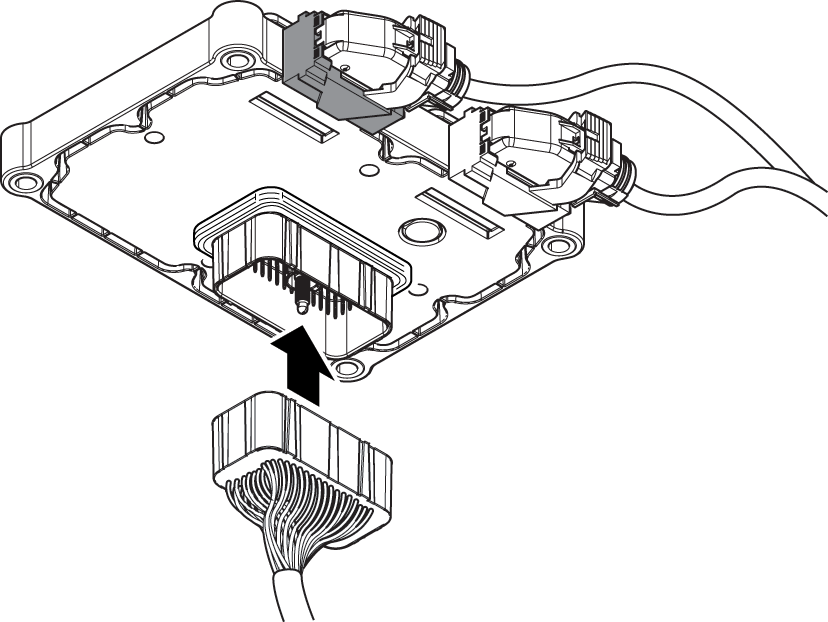
Measure resistance at Eaton Breakout Box between Pin 73 and Pin 74. Record reading in table.
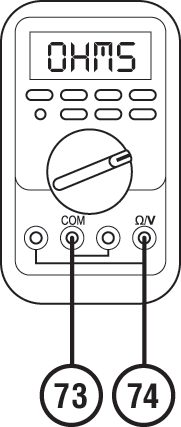
Key on.
Measure voltage at Eaton Breakout Box between Pin 72 and Pin 74. Record reading in table.
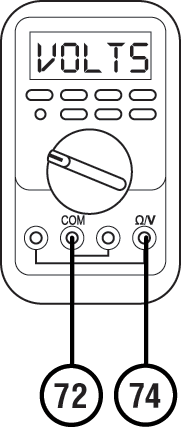
Compare reading(s) in table.
If readings are in range, replace Mechatronic Transmission Module (MTM). Go to Step V
Note: MTM removal and installation requires transmission be removed from vehicle. Reference Endurant XD Service Manual TRSM0960, Transmission Removal Service Procedure.
If readings are out of range, replace Transmission Control Module (TCM). Go to Step V
| Ignition State | Pins | Range | Reading(s) |
|---|---|---|---|
| Key off | 73 to 74 | 7.5k–22k Ohms | |
| Key on | 72 to 74 | 4.75–5.25 V |
Key off.
Remove MTM.
Note: MTM removal and installation requires transmission be removed from vehicle. Reference Endurant XD Service Manual TRSM0960, Transmission Removal Service Procedure.
Install MTM Alignment Tool (RR1086TR-1) onto main housing.
Note: Reference Appendix, Manually Actuate Rail E Procedure.
Using the Rail E Lever, move Rail E to neutral position (if necessary).
Shift Rail E into High Range engagement position (fore) and return to neutral position.
Shift Rail E into Low Range engagement position (aft) and return to neutral position.
Contact Eaton Cummins Automated Transmission Technologies at +1 800-826-4357 for further diagnostic instructions. Go to Step V
Refer to Endurant XD Service Manual TRSM0960, Mechatronic Transmission Module (MTM) Service Procedure.
Verify notch on Rail E is facing up.
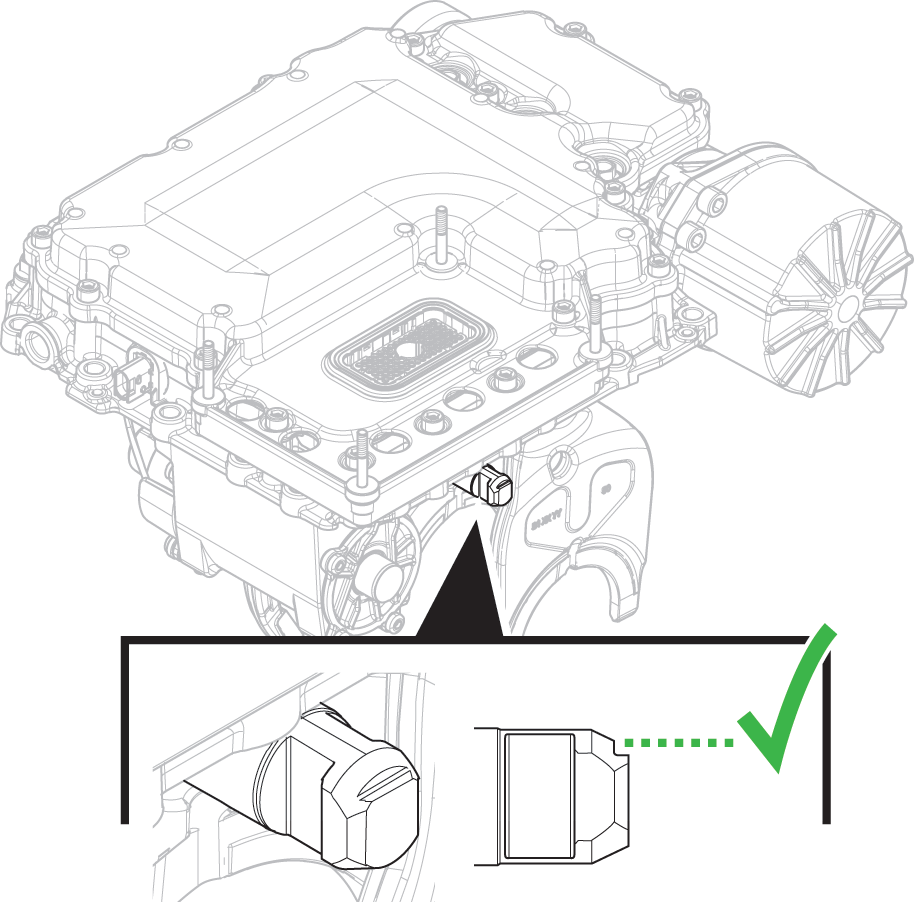
If MTM was installed with notch on Rail E facing down, refer Endurant XD Service Manual TRSM0960, Mechatronic Transmission Module (MTM) Service Procedure. Go to Step V
Note: If MTM is installed on the transmission with the notch on Rail E facing down, Fault Code 320 (SPN 5942) FMI 9 sets Active and the transmission will not shift out of neutral.
If MTM was installed with notch on Rail E facing up, Contact Eaton Cummins Automated Transmission Technologies for further diagnostic instructions. For Help Line phone numbers, go to Contact Information. Go to Step V
Key off.
Reconnect all connectors and verify all components are properly installed.
Key on with engine off.
Connect ServiceRanger.
Go To “Fault Codes”.
Select “Clear All Faults”.
Operate vehicle and attempt to reset the fault code or duplicate the previous complaint.
Check for fault codes using ServiceRanger.
If no fault codes set and vehicle operates properly, test complete.
If Fault Code 320 sets Active, Go to Step A
If a fault code other than 320 sets Active, troubleshoot per the Fault Code Isolation Procedure Index.